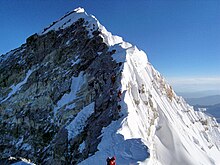Death zone
In mountaineering, the death zone refers to altitudes above which the pressure of oxygen is insufficient to sustain human life for an extended time span.
[11][12] Humans have survived for 2 years at 5,950 m (19,520 ft) [475 millibars (14.0 inHg; 6.89 psi) of atmospheric pressure], which appears to be near the limit of the permanently tolerable highest altitude.
[13] At extreme altitudes, above 7,500 m (24,600 ft) [383 millibars (11.3 inHg; 5.55 psi) of atmospheric pressure], sleeping becomes very difficult, digesting food is near-impossible, and the risk of HAPE or HACE increases greatly.
[1][4][5] Scientists at the High Altitude Pathology Institute in Bolivia dispute the existence of a death zone, based on observation of extreme tolerance to hypoxia in patients with chronic mountain sickness and normal fetuses in-utero, both of which present pO2 levels similar to those at the summit of Mount Everest.
[17] Physiologist Griffith Pugh was on the 1952 and 1953 expeditions to study the effects of cold and altitude; he recommended acclimatising above 4,600 m (15,000 ft) for at least 36 days and the use of closed-circuit equipment.

